Hockey drills for technique attack / offense
Goal
: Searching for the flanks instead of passing the ball through the middle of the field. Teams will look for solutions and tend to shift the game. The % of ball possession will also go up.
Set up
:Two teams are made. The size of the teams depends on the number of players available. In the middle of the field there is a square or rectangle which marks where both ball and player may not pass.
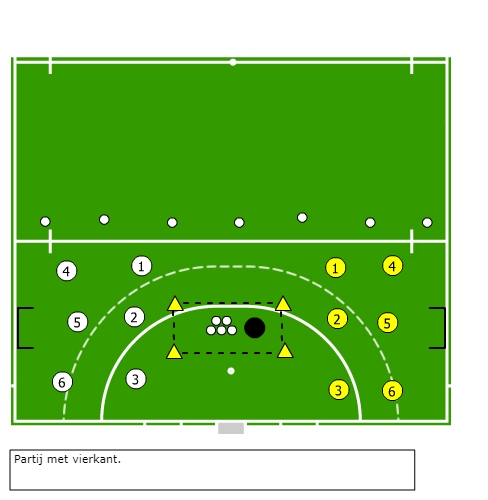
Variations:
- You can change the size of the square or rectangle to adjust the difficulty. The bigger this field, the more difficult it becomes.
- You can agree that you can walk through the field, but that the ball cannot pass through.
NB Make sure that there are no objects in the box and preferably use flat cones to prevent tripping up. - If there are an odd number of players, you can play with a 'chameleon'. This player will join the attacking team and change roles all the time.
- Place balls at the side of the field, so that when a ball is out, a new ball can be picked up to continue play.
- As trainer, stand in the middle of the field and coach both teams.
Goal
: The goal of this exercise is to actively pass between the ball and the defender, making yourself playable
Set-up
:In order to run this exercise properly, you need a minimum number of players. You can play with this when you make the exercise one station shorter.
- The player at B starts walking and runs with a curve past the orange pawns. By doing so, he offers himself for play.
- The player at A plays into the run-in player and runs around the indicated cones towards point B.
- The player with C runs in a curve around the orange cones. The moment of starting is important. He pays attention to how far the player at point B is.
- The player at point B plays into the player who left from point C.
- The player at point C receives the ball in front of the orange cones, runs with it into the circle and rounds the goal.
- The player who completed runs around the cones back to point A.
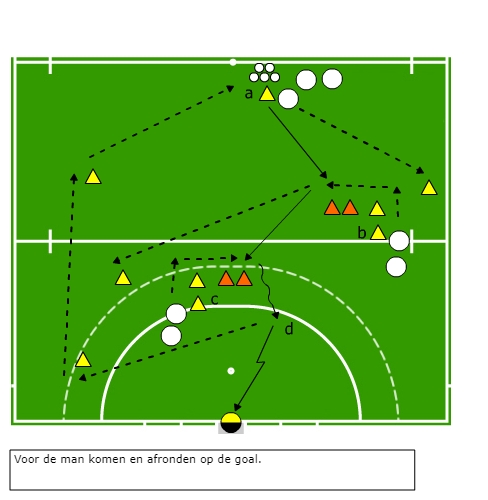
Variations:
- By removing one station, you can make the exercise smaller, requiring fewer players.
- The position from which the player who passes runs in front of the man starts can be changed. You can e.g. move point B more to the inside of the play area, making the direction of play different.
- You can also create an extra station near the goal for someone who is about to tip in Please note that you will need several players for this.
Points of attention:
- When floating, the ball is attached to the stick. This makes it almost impossible to take the ball away without committing a foul.
- When offering the ball, you have to make yourself wide so you can get between the ball and the defender
- Starting the run can be difficult to time, so pay extra attention to this
- The passes should be made in front of the orange cones, so that you are clearly running in front of the man
Passing in the run and finishing on goal
Objective:
Being able to combine, run with and without the ball, turn open, pass and finish on goal.
Set-up:
For the exercise at least 2 participants are active. When you also work with a goalkeeper, a third person is active.
- Player 1 has no ball and starts running from point A to point B.
- Player 2 stands on point E and stays there during the exercise. Player 2 plays the ball to player 1 in the run.
- When player 1 arrives at point B, he plays the ball back to player 2 and continues to point C.
- Player 2 plays the ball to point C so that player 1 can take it there.
- Player 1 turns inside and walks to the head of the circle.
- At point D, player 1 rounds the goal and runs out the exercise on the right side so he can run around point C and take over player 2's spot.
- After handing off player 2's final pass, he runs to point A and closes in at the back.
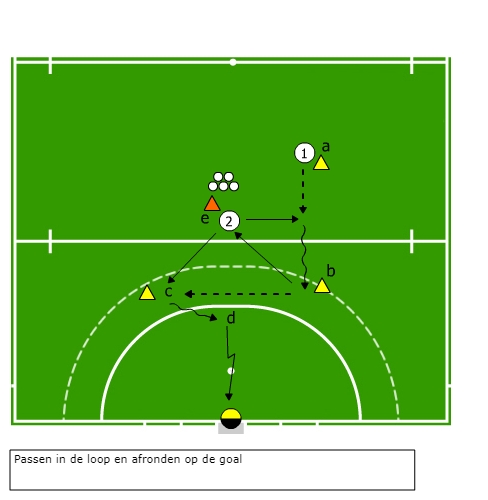
Variations:
- At point B, instead of passing the ball directly to player 2, player 1 can do a Swivel. In this way the player learns to put his body between the ball and the opponent.
- Player 2 can also pass to player 1 in the run from point B to point C. This trains you even more on passing and taking on in the run.
- The whole exercise can also be done in mirror image.
- Instead of one player on point E you can also have two different players make the pass. In that case, after the first pass, player 2 runs through and another player takes the ball and passes it to point C.
- If player 1 is fast enough, player 2 can also bounce the ball from point E to point C. This increases the difficulty by increasing the speed and adding the bounce.
2 attackers and 1 defender.
- Attacker plays the ball to the other attacker
- The defender puts pressure
- The attackers try to score
- If they succeed, the game starts again.
- Player 1 plays the ball with a hard push into the attacker who has come running from the spot.
- The attacker takes the ball strongly and passes it back.
- Player 1 plays the ball to the side.
- The player on the side plays the ball directly to the corner.
- Now the team can shift via the left.
Finish the training with a match shape on a half pitch
You can adjust the width of the field depending on the size of your team at the training.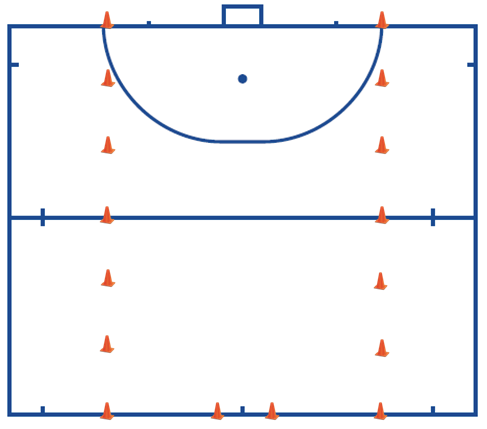
Two teams with substitutes, substitutions are made when a goal is scored.
Each person defends a goal, on each field there are 5 goals, so there are also 5 people who defend these goals.
If a goal is scored in your goal, you have to sit on the sidelines and you become a substitute. A new player (substitute) from the side enters the field and will defend the goal.
If a goal is scored, it is 1 point. The team that has the most points at the end of the game is the winner.
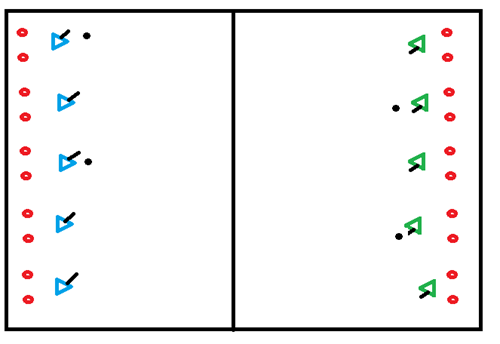
Overplaying to score
Two players continuously play over the ball until one student is so close to the goal that he can score in the goal.
Variation 2-1 situation:
Under pressure from the defender, the attackers must now play together and try to score. The defender can score a point by conquering the ball and then dribbling over the dead ball line. This is the short side without a goal.
Overplaying to score
Two players continuously play over the ball until one student is so close to the goal that he can score in the goal.
Variation 2-1 situation:
Under pressure from the defender, the attackers must now play together and try to score. The defender can score a point by conquering the ball and then dribbling over the dead ball line. This is the short side without a goal.
Goal: Improve passing. To improve finishing on goal.
Organisation: Half playing field 2 attackers (Z) â€" 1 goalkeeper Course with 1,2-ties, dribbling and finishing on goal. After each pass you have to run to get the ball back from the attacker.
Tip: Before shooting on goal, pay attention to the position of the goalkeeper!
Variations: Practise different passing moves, both anti-clockwise and clockwise.
Try to pass your opponent over his backhand side, which is also your forehand side (and accelerate, when you pass your opponent)
When the ball rolls to the left, you can get it to your forehand with your tip to the right
If the attacker passes the ball back to the support player, the support player can pass the ball to the other side of the field (move the ball).
The defender on the side of the field, where the ball is not, must always stay behind the other defender (in 6-a-side hockey).







